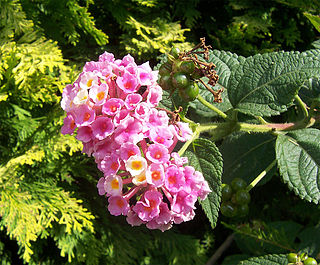
The Verbenaceae, the verbena family or vervain family, is a family of mainly tropical flowering plants. It contains trees, shrubs, and herbs notable for heads, spikes, or clusters of small flowers, many of which have an aromatic smell.

Volkameria is a genus of flowering plants in the family Lamiaceae. It is pantropical in distribution. Many of the species are found in coastal habitats.

Clerodendrum thomsoniae is a species of flowering plant in the genus Clerodendrum of the family Lamiaceae, native to tropical west Africa from Cameroon west to Senegal. It is an evergreen liana growing to 4 m (13 ft) tall, with ovate to oblong leaves 8–17 cm (3–7 in) cm long. The flowers are produced in cymes of 8–20 together, each flower with a pure white to pale purple five-lobed calyx 2.5 cm in diameter, and a red five-lobed corolla 2 cm long and in diameter. The flowers are born in cymose inflorescences arising from the axils of the leaves. The leaves, in turn, are arranged opposite to each other and at right angles to the pairs above and below.
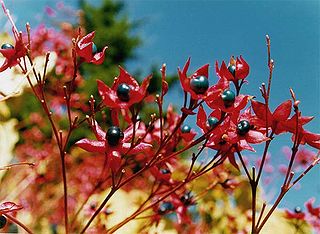
Clerodendrum is a genus of flowering plants formerly placed in the family Verbenaceae, but now considered to belong to the Lamiaceae (mint) family. Its common names include glorybower, bagflower and bleeding-heart. It is currently classified in the subfamily Ajugoideae, being one of several genera transferred from Verbenaceae to Lamiaceae in the 1990s, based on phylogenetic analysis of morphological and molecular data.

Dialium cochinchinense, the velvet tamarind, is a species of flowering plant in the family Fabaceae. It is native to Ghana, Sri Lanka, Cambodia, Laos, Malaysia, Myanmar, Nigeria, Thailand, Vietnam and many west African countries. It is threatened by habitat loss.
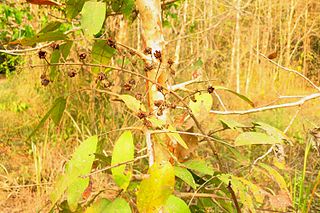
Cratoxylum cochinchinense is a plant now placed in the family Hypericaceae. The specific epithet cochinchinense is from the Latin meaning "of Cochinchina". In Vietnamese C. cochinchinense is usually called thành ngạch nam or lành ngạnh nam, other names include: hoàng ngưu mộc, hoàng ngưu trà and đỏ ngọn.

Clerodendrum quadriloculare is a species of flowering plant native to New Guinea and the Philippines. It is one of many species previously included in the family Verbenaceae, but transferred to the Lamiaceae based on molecular studies. The plants produce flowers which look good in a garden, but it can be difficult to eradicate.
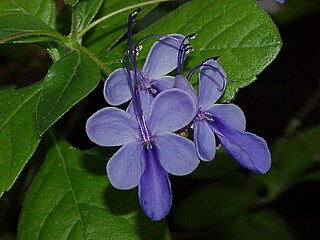
Rotheca is a genus of flowering plants in the family Lamiaceae. Estimates of the number of species in the genus vary from about 35 to as many as 60. Three of the species are native to tropical Asia, with the rest occurring in Sub-Saharan Africa. The type species for the genus is Rotheca serrata. It had originally been named Rotheca ternifolia, but this name is now considered illegitimate.

Clerodendrum tomentosum, known as the downy chance, hairy lolly bush, hairy clairy or hairy clerodendrum is a shrub or small tree occurring in eastern and northern Australia. Distributed from Batemans Bay in southern coastal New South Wales, Queensland, Northern Territory, Western Australia, and New Guinea.

Clerodendrum floribundum, known as the lolly bush or smooth clerodendrum, is a shrub or tree found in Australia and New Guinea. The habitat is in or at the margins of coastal rainforests, up to 300 metres above sea level. In Western Australia it grows in drier areas; such as rocky sites, gorges, cliffs, floodplains and creek beds.

Clerodendrum infortunatum, known as bhat or hill glory bower, is a perennial shrub belonging to the family Lamiaceae, also sometimes classified under Verbenaceae. It is the type species among ~150 species of Clerodendrum. It is one of the most well-known natural health remedies in traditional practices and siddha medicine.

Clerodendrum phlomidis is a species of flowering plant in the family Lamiaceae. The plant has been used in Ayurvedic medicine, and some Ayurvedic sources refer to it by the synonym Clerodendrum multiflorum.
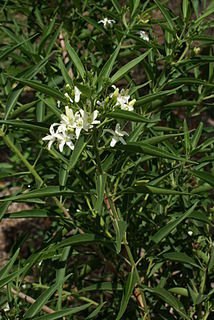
Clerodendrum heterophyllum is a species of flowering plant in the genus Clerodendrum of the family Lamiaceae. It is a native to Mauritius and La Réunion.
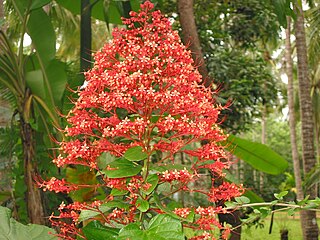
Clerodendrum paniculatum, the pagoda flower, is a species of flowering plant in the genus Clerodendrum and family Lamiaceae. It is native to tropical Asia and Papuasia, Fiji, French Polynesia, and Central America.

Karomia speciosa is an African deciduous large shrub or bushy tree up to 7 m, and relocated to the family Lamiaceae from Verbenaceae. It is one of 9 species in the genus Karomia, a genus containing species previously classified in Holmskioldia, and is closely related to Clerodendrum. The only remaining species in the genus is Holmskioldia sanguinea, occurring in the foothills of the Himalayas.
Xerospermum is a small genus of Asian plants of the family Sapindaceae.

Clerodendrum bungei, commonly known as rose glory bower, glory flower or Mexican hydrangea, is a species of flowering plant in the deadnettle family, Lamiaceae. Native to China, it is commonly grown in gardens as an ornamental shrub. It has escaped from cultivation and is naturalized in the Americas.

Clerodendrum palmatolobatum is an Asian species of flowering plant in the family Lamiaceae. C. palmatolobatum is found in Cambodia and Vietnam, where it may be called ngọc nữ lá chân vịt: meaning [ngọc nữ = Clerodendrum] with leaves like duck's feet.

Clerodendrum chinense, called the glory bower, is a species of flowering plant in the genus Clerodendrum. It is native to Nepal, the eastern Himalayas, Assam, the Andaman and Nicobar Islands, south-central and southeast China, Southeast Asia, and Malesia. A popular garden plant, it has been widely introduced to the rest of the world, including Florida, the Caribbean, Bermuda, Central America, the Galápagos, South America, Ascension Island, the Gulf of Guinea islands, East Africa, the Seychelles, Pakistan, India, the Lesser Sunda Islands, Taiwan, the Cook Islands, Fiji, Niue, and the Society Islands. It has gained the Royal Horticultural Society's Award of Garden Merit. It is a perennial shrub that grows up to 3 metres tall.
Cracosna is a genus of flowering plants belonging to the family Gentianaceae.

















